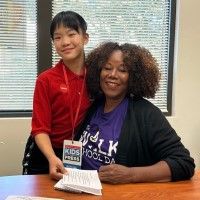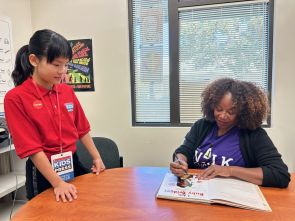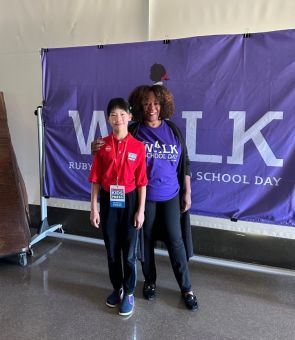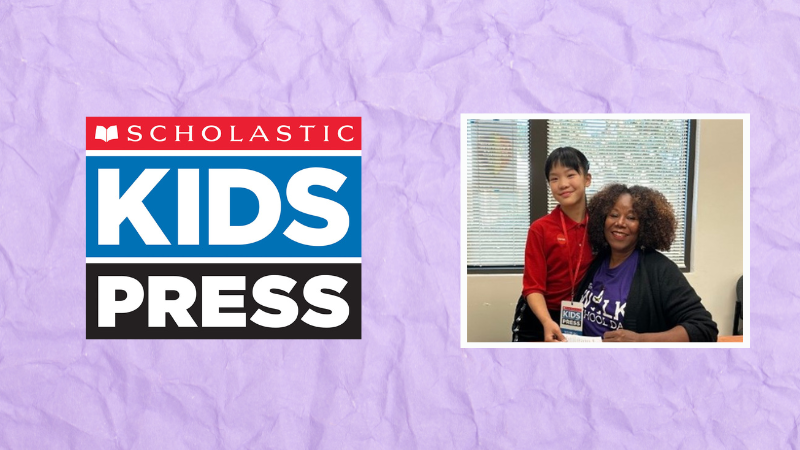 We interviewed Kid Reporter Enya Yang as part of a series celebrating Women’s History Month. Enya, who loves reading and wants to become an author, spoke to us about her experience as a reporter, what it was like to interview Scholastic author Ruby Bridges, and why Women’s History Month is important. You can also check out Enya’s interview with Ruby on our Kids Press website!
We interviewed Kid Reporter Enya Yang as part of a series celebrating Women’s History Month. Enya, who loves reading and wants to become an author, spoke to us about her experience as a reporter, what it was like to interview Scholastic author Ruby Bridges, and why Women’s History Month is important. You can also check out Enya’s interview with Ruby on our Kids Press website!
What is it like to be a Scholastic Kid Reporter?
Being a Kid Reporter is an amazing experience. I really enjoy getting to meet all these amazing new people. And I also think that it helped me academically – my grades have even improved.
What’s your favorite part about reporting?
That’s a very difficult question. There are so many great things! If I had to choose, I’d say getting to visit so many different places. It inspires me to look out because I don’t usually go farther than my neighborhood. When you’re researching topics, you have to think, “What’s interesting? What will attract others?” So I think the best part is going to the places I like and sharing them with others, as well.
How do you decide what stories to write about?
What I do is find the most interesting things, maybe an endangered animal or a new exhibition or something like that. I write them down, and then I go to my classmates and ask which ones they would be most interested in, because I want to attract my readers. Then I go with the topic that works best with my writing. Going out into the environment and asking around is a key step.
What was it like to interview Ruby Bridges?
Ruby Bridges was visiting a school near my house, so I went to watch her talk to and interact with the kids. Then I had a one-on-one with her. I must admit I was a little bit nervous at first. But when she greeted me, she was just so nice. I instantly warmed up to her. I really hope I can meet her again—she is an amazing person.
She had this almost magical connection with the kids, and I found it so nice. She knows just the right way to talk to you. She told the kids, “You look like a bag of M&Ms” to explain how everyone is unique and no one looks exactly the same. She simplified the concept and said it in a way that was easy for the kids to understand, and I really admired that about her.
She also told kids about helping others. She told them, “On this day, I want you to think of one thing you can do to help the environment or help the community,” and I think that really inspired them. I really enjoyed seeing their faces, thinking and laughing, and then she took so many questions.
Ruby likes to travel to different cities to visit schools and talk to the kids a little bit, and I think it’s really helpful. She wants them to understand how she felt because she believes that her lesson is very similar to Martin Luther King Jr.’s: that you can’t judge a person by the color of their skin, but by the content of their character. She wants the kids to know that they’re safe, that everyone is different, and that they should respect one another’s cultures and ideas.
What did you learn from meeting her?
 She really inspired me. There’s not an adjective to describe the feeling. It was just incredible to meet her, because she was one of the first children to integrate an all-white school. I felt a mixture of heartbreak and admiration because she admitted that it was only her innocence that saved her from the mobs. I found her courage really inspiring. If I learned something, it would be that no matter their skin color, where they’re from or their religion, so many people are just amazing and so admirable. She showed me how you can relate your ideas to one another.
She really inspired me. There’s not an adjective to describe the feeling. It was just incredible to meet her, because she was one of the first children to integrate an all-white school. I felt a mixture of heartbreak and admiration because she admitted that it was only her innocence that saved her from the mobs. I found her courage really inspiring. If I learned something, it would be that no matter their skin color, where they’re from or their religion, so many people are just amazing and so admirable. She showed me how you can relate your ideas to one another.
Did you read her books?
I read all three books, and I really enjoyed them. I think I enjoyed I Am Ruby Bridges the most due to the humor. I even asked her what she wrote about in that book that was different from the other books, and she said that many people don’t know she has a sense of humor. I saw her sense of humor pretty quickly! She said that she wanted kids to understand and that since they are humorous and like to laugh, she wanted to include her childish thoughts in the book because they were very funny, even though she didn’t realize it at the time. She put in small details like how she didn’t like her name, and she thought it was a name for a grandma.
Are there any other women you look up to?
I really look up to authors. Women couldn’t always go to school, so I appreciate and am really inspired by women who were writers and artists even when they weren’t allowed to get an education. They still changed the world even though they didn’t get to have the educational experiences we have today, andthat’s what I admire. I admire anyone who wrote a book or made art or did something academic.
What does Women’s History Month mean to you?
I must say I really am happy that there is a month for women because I think that if anyone should be appreciated, it should be women. And I think that there are so many women who changed the world and changed the way people thought. It’s really amazing once you think about it!
I think about Women’s History Month in a different way now because I view the people who changed the world and I think, “Imagine changing the world by yourself.” For one person to change the world, to change how people thought – these women persisted and kept sharing either in speeches or books, and I really admire that.
Is there anything else you want to share?
 I want to share that Ruby Bridges was so inspiring that the artist Norman Rockwell actually made a painting of her depicting her first day of school. And he made it of her holding her mother’s hand surrounded by the federal marshals as they walked her through to the building. He labeled it “the problem we all live with.” I think that shows how much she changed opinions because not many people gave it a thought until she started to integrate the schools. And it spread far – many families in the North sent her money. They supported her parents, and she would receive little boxes of toys and candy and money, and I think that really helped her get through that difficult period, especially when the town began to turn on her parents. Her father even lost his job, and the shopkeepers wouldn’t sell anything to her mother, so I think the boxes of appreciation definitely warmed their hearts and made them inspired to keep trying. During that school year, she walked through that crowd almost every single day, and yet she never missed a day of school.
I want to share that Ruby Bridges was so inspiring that the artist Norman Rockwell actually made a painting of her depicting her first day of school. And he made it of her holding her mother’s hand surrounded by the federal marshals as they walked her through to the building. He labeled it “the problem we all live with.” I think that shows how much she changed opinions because not many people gave it a thought until she started to integrate the schools. And it spread far – many families in the North sent her money. They supported her parents, and she would receive little boxes of toys and candy and money, and I think that really helped her get through that difficult period, especially when the town began to turn on her parents. Her father even lost his job, and the shopkeepers wouldn’t sell anything to her mother, so I think the boxes of appreciation definitely warmed their hearts and made them inspired to keep trying. During that school year, she walked through that crowd almost every single day, and yet she never missed a day of school.



